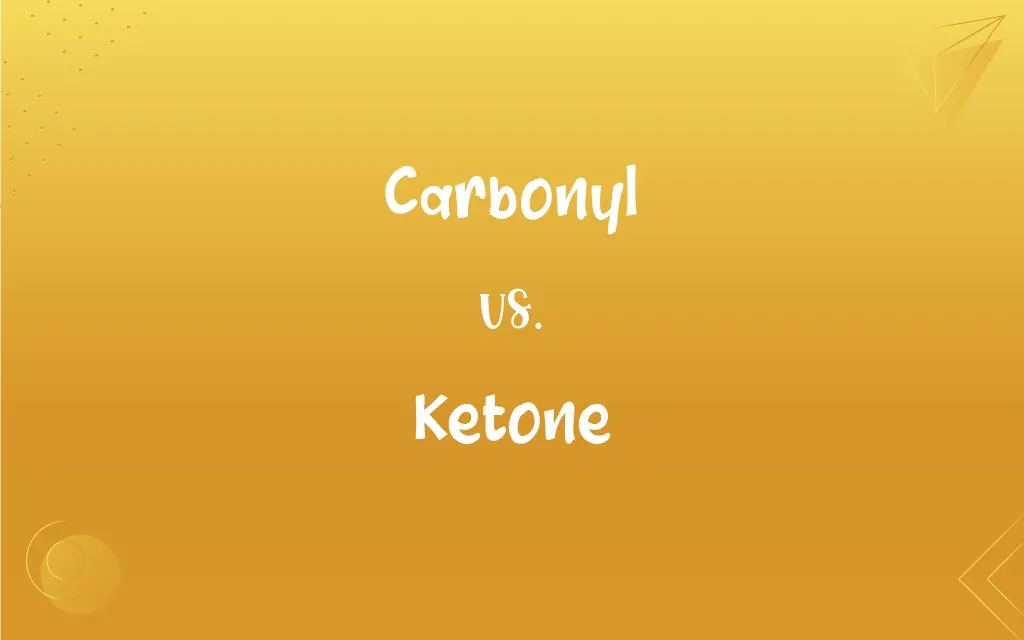Carbonyl vs. Ketone: What's the Difference?
Edited by Janet White || By Harlon Moss || Published on January 3, 2024
A carbonyl group is a functional group consisting of a carbon atom double-bonded to an oxygen atom; a ketone is an organic compound containing a carbonyl group bonded to two carbon atoms.

Key Differences
A carbonyl group is a functional group found in organic chemistry, characterized by a carbon atom double-bonded to an oxygen atom (C=O). Ketones are a specific type of organic compound where the carbonyl group is bonded to two other carbon atoms.
The carbonyl group is a key feature in various organic compounds, including ketones and aldehydes. Ketones differ from aldehydes in that the carbonyl group in aldehydes is bonded to at least one hydrogen atom.
In a carbonyl group, the double bond between carbon and oxygen is highly reactive, making it a significant site for chemical reactions. Ketones, having the carbonyl group within the carbon chain, are often less reactive than aldehydes.
Carbonyl groups contribute to the properties and reactivity of the molecules they are part of. Ketones are typically found in sugars, fragrances, and in industrial applications.
The presence of a carbonyl group can significantly impact the chemical behavior of a molecule. Ketones, due to their specific structure, have unique properties and uses in organic chemistry.
ADVERTISEMENT
Comparison Chart
Definition
A functional group (C=O)
Organic compound with a carbonyl group bonded to two carbons
Occurrence
Found in various organic compounds
A specific type of carbonyl-containing compound
Reactivity
Highly reactive
Generally less reactive than aldehydes
Bonding
Carbon double-bonded to oxygen
Carbonyl group bonded within a carbon chain
Examples and Applications
Present in ketones, aldehydes, acids
Used in fragrances, solvents, and biochemistry
ADVERTISEMENT
Carbonyl and Ketone Definitions
Carbonyl
Central to various organic compounds.
The reactivity of the carbonyl group is crucial in organic synthesis.
Ketone
Organic compound with a carbonyl group bonded to two carbons.
Acetone is a simple and well-known ketone.
Carbonyl
Reactive site in organic chemistry.
Many reactions in organic chemistry involve the carbonyl group.
Ketone
Found in sugars and fragrances.
Some ketones have distinct and pleasant odors.
Carbonyl
Found in ketones, aldehydes, and acids.
The carbonyl group is a common link between different types of organic molecules.
Ketone
Less reactive than aldehydes.
In ketones, the carbonyl group's reactivity is moderated by its position.
Carbonyl
Functional group with a carbon atom double-bonded to oxygen.
The carbonyl group is essential in many biological processes.
Ketone
A type of carbonyl-containing compound.
Ketones are often used as solvents in the paint industry.
Carbonyl
Characterized by a C=O bond.
The carbonyl group influences the boiling point of a compound.
Ketone
Used in industrial and biological applications.
Ketones play a role in metabolic processes in the body.
Carbonyl
The bivalent group C=O.
Ketone
Any of a class of organic compounds, such as acetone, characterized by having a carbonyl group in which the carbon atom is bonded to two other hydrocarbon groups and having the general formula R(CO)R′, where R may be the same as R′.
Carbonyl
A metal compound, such as Ni(CO)4, containing the CO group.
Ketone
See ketone body.
Carbonyl
(organic chemistry) In organic chemistry, a divalent functional group, (-CO-), characteristic of aldehydes, ketones, carboxylic acids, amides, carboxylic acid anhydrides, carbonyl halides, esters and others.
Ketone
(organic compound) A homologous series of organic molecules whose functional group is an oxygen atom joined to a carbon atom—by a double bond—in a carbon-hydrogen based molecule.
Carbonyl
(inorganic chemistry) Any compound of a metal with carbon monoxide, such as nickel carbonyl, Ni(CO)4.
Ketone
One of a large class of organic substances resembling the aldehydes, obtained by the distillation of certain salts of organic acids and consisting of carbonyl (CO) united with two hydrocarbon radicals. In general the ketones are colorless volatile liquids having a pungent ethereal odor.
Carbonyl
The radical (CO)´´, occuring, always combined, in many compounds, as the aldehydes, the ketones, urea, carbonyl chloride, etc.
Ketone
Any of a class of organic compounds having a carbonyl group linked to a carbon atom in each of two hydrocarbon radicals
Carbonyl
A compound containing metal combined with carbon monoxide
Carbonyl
Relating to or containing the carbonyl group
FAQs
What are ketones?
Ketones are organic compounds that contain a carbonyl group bonded to two carbon atoms.
How are ketones different from aldehydes?
Ketones have the carbonyl group bonded to two carbons, while aldehydes have it bonded to at least one hydrogen.
What is a carbonyl group?
A carbonyl group is a functional group consisting of a carbon atom double-bonded to an oxygen atom.
What makes the carbonyl group reactive?
The double bond between carbon and oxygen in the carbonyl group is highly reactive.
What are common uses of ketones?
Ketones are used in solvents, fragrances, and in biochemical processes.
Can carbonyl groups be found in sugars?
Yes, carbonyl groups are present in certain sugars.
Is acetone a ketone?
Yes, acetone is a simple and commonly used ketone.
What is the significance of ketones in metabolism?
Ketones play a role in energy production in the body, especially during carbohydrate restriction.
How do carbonyl groups affect boiling points?
The presence of a carbonyl group can increase the boiling point of a compound.
Where is the carbonyl group found?
The carbonyl group is found in various organic compounds, including ketones, aldehydes, and acids.
How are ketones used in the paint industry?
Ketones serve as effective solvents in various types of paint.
Are carbonyl groups present in fatty acids?
Yes, some fatty acids contain carbonyl groups.
Do ketones have any biological significance?
Ketones are important in several biological processes, including as energy sources.
Are all carbonyl-containing compounds ketones?
No, only those with the carbonyl group bonded to two carbon atoms are ketones.
What is the simplest ketone?
Acetone is considered the simplest ketone.
Are ketones reactive?
Ketones are generally less reactive than aldehydes due to their structural arrangement.
What role do carbonyl groups play in organic chemistry?
Carbonyl groups are crucial in many organic reactions and influence the properties of molecules.
Can ketones be found in fragrances?
Yes, some ketones have distinct aromas and are used in fragrances.
Can carbonyl groups form hydrogen bonds?
Yes, the oxygen in the carbonyl group can form hydrogen bonds.
Are ketones soluble in water?
Smaller ketones are usually soluble in water, but solubility decreases with increasing chain length.
About Author
Written by
Harlon MossHarlon is a seasoned quality moderator and accomplished content writer for Difference Wiki. An alumnus of the prestigious University of California, he earned his degree in Computer Science. Leveraging his academic background, Harlon brings a meticulous and informed perspective to his work, ensuring content accuracy and excellence.
Edited by
Janet WhiteJanet White has been an esteemed writer and blogger for Difference Wiki. Holding a Master's degree in Science and Medical Journalism from the prestigious Boston University, she has consistently demonstrated her expertise and passion for her field. When she's not immersed in her work, Janet relishes her time exercising, delving into a good book, and cherishing moments with friends and family.






































































